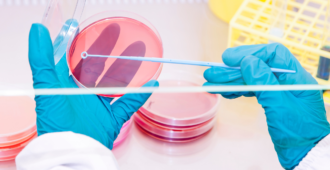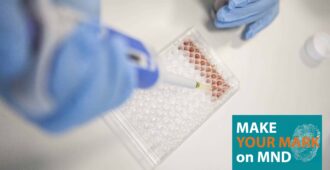It could be easy to assume that one motor neurone is pretty much like another, but a series of presentations on Thursday clearly showed that we need to be a little more sophisticated in our thinking.
Dr Hynek Wichterle (Columbia University) discussed how in the developing embryo, there are distinct regional subtypes of motor neurones in the spinal cord. For example, the motor neurones at the bottom of the spine can be easily distinguished from those at the top of the spine by the pattern of genes that are switched on and off – in a nutshell, different motor neurones have their own regional ‘postcode’.
Dr Wichterle went on to show that you can generate motor neurones with specific postcodes in the lab, from embryonic stem cells . Having motor neurones that hopefully reflect different aspects of MND will allow researchers to better understand the subtleties of motor neurone function and develop more relevant treatment approaches.
It’s well known that some motor neurones are particularly resistant to the disease, such as the so called ‘oculomotor neurones’ that control eye movements. By looking at the pattern of genes being switched on and off in early mouse embryonic development, Dr Wichterle was able to induce the same pattern in mouse stem cells to create what look very much like oculomotor neurones in the dish. There is some further work to be done to check that they are indeed what he thinks they are, but they could be a very important tool in helping to understand why some motor neurones are tougher than others.
Continuing the theme, Dr Georg Haase (Marseille) introduced an elegant way of separating different populations of motor neurones from mouse spinal cord. He focused on two subtypes of motor neurone – those that connect to the limb muscles and those that connect to the main trunk of the body. After they are separated out, they can be grown in culture (in a dish in the lab) . He then showed that these two different subtypes of motor neurone acted very differently in their response to chemicals known as neurotrophic factors . The word neurotrophic can be literally translated as ‘nerve nourishing’ and these chemical compounds have attracted a lot of attention in the past as possible therapies for MND, with a couple being tested in large clinical trials . Unfortunately these trials have not shown any effect, but this could be because – as Dr Haase showed in his lab studies – each neurotrophic factor only acts on a proportion of motor neurones. He suggested that the different ‘survival profiles’ he sees in his cellular studies provide a rationale for selecting combinations of different neurotrophic factors for further testing in mice – and hopefully in man.
Prof Pam Shaw (University of Sheffield) also asked the question of what makes oculomotor neurones different, but her presentation took us from mouse to man. Using a technique called laser capture microdissection, which allows individual motor neurones to be removed from post mortem spinal cord tissue form MND patients, she and her colleagues are able to examine which genes were switched on and off in the cells. Research like this requires very high quality tissue, removed shortly after death, but Sheffield happens to host one of the best MND tissue banks in the country.
She compared these ‘gene expression patterns’ in the disease-resistant oculomotor neurones with the more vulnerable motor neurones from the lower spinal cord. There were considerable differences in the patterns, with a much larger number of genes being switched on in the oculomotor neruones. Many of these genes could be dividied into functional families, which act on a similar biological pathway. Key protective processes activated included neurotransmission, mitochondrial function and proteasomal function – all of which are strongly implicated in MND. If human oculomotor neurones survive by gearing up these protective pathways, it provides possibilities that drugs can be found which act in the same way.
Our International Symposium website news stories:
International Symposium closes in Chicago
International Symposium focuses on clinical trials
International Symposium focuses on carer and family support
International Symposium begins in Chicago
Researchers unite at our International Symposium on MND
After you’ve finished reading the symposium articles that interest you, we’d be grateful if you could spare a few minutes to fill in our short online survey on our symposium reporting. Your comments really are useful and allow us to continually improve our symposium reporting. surveymonkey.com/s/alssymp




Comments are closed.